When Polly Robinson was growing up in Cumbria, there was always a home-built boat for the family to use. Her father and grandfather were hobby boatbuilders, and she attributes her love of being on the water to them. Long before she was born, her grandfather built a pram dinghy in which her father and aunt learned to sail. It stayed in the family and, when they were old enough, Polly and her sisters learned to sail in it too. A generation later, Polly’s two children used it. Beyond sailing and rowing, Polly’s grandfather also introduced her to boatbuilding. When she was 9, she helped him to build a Selway Fisher Wren, a stitch-and-glue canoe. Now, she has built another stitch-and-glue Selway Fisher design, the 7′ 6″ Redshank, a lapstrake rowboat based on a traditional English dinghy.
 Photographs courtesy of Polly Robinson
Photographs courtesy of Polly RobinsonStitching the strakes together would become increasingly nerve-wracking as Polly progressed up the sides of the hull and the curve became exaggerated around the generous beam.
In 2022, Polly was working at Fyne Boat Kits in Kendal, Cumbria. During the two years she had been with the company a diminutive stem dinghy, all stitched up but not glued and far from finished, had stood in one corner of the boatbuilding shop where weeklong classes were held. When Polly came in to work one day, the boat was gone. She didn’t think much of it until a colleague told her it had been thrown out, but that he had rescued it from the dumpster. He felt sorry for it, saying it deserved better than to be simply thrown away. He thought he should ask Polly if she would be interested in finishing the boat. He knew she’d built a Kaholo paddleboard and a 9′ 6″ Grain Waterlog surfboard and had been talking about building something else.
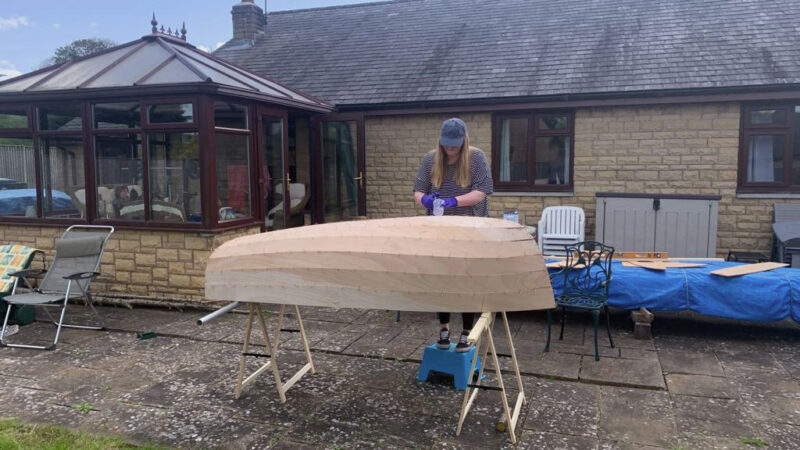
Once all the planks were stitched into place Polly moved the project outside, inverting the hull to apply thickened epoxy between the laps.
“It was true,” Polly says. “I had been chatting about building something more than a surfboard. I keep a Cornish Coble on a swinging mooring on Coniston Water—where Arthur Ransome based the Swallows and Amazons books—and I wanted a tender for it. We had an inflatable, and it did the job, but it wasn’t the prettiest.”
Polly went to look at the dumpster-salvage dinghy parts. At first glance it seemed like everything she needed was there: strakes, thwarts, knees, forward and aft bulkheads, ’midship frame. There was no transom, but she knew she could cut one on the CNC router at work. Also missing were the hardwood gunwale pieces, copper wire for stitching, fittings, and fastenings, but Polly knew she could source everything locally. She loaded the kit into her car and drove home.
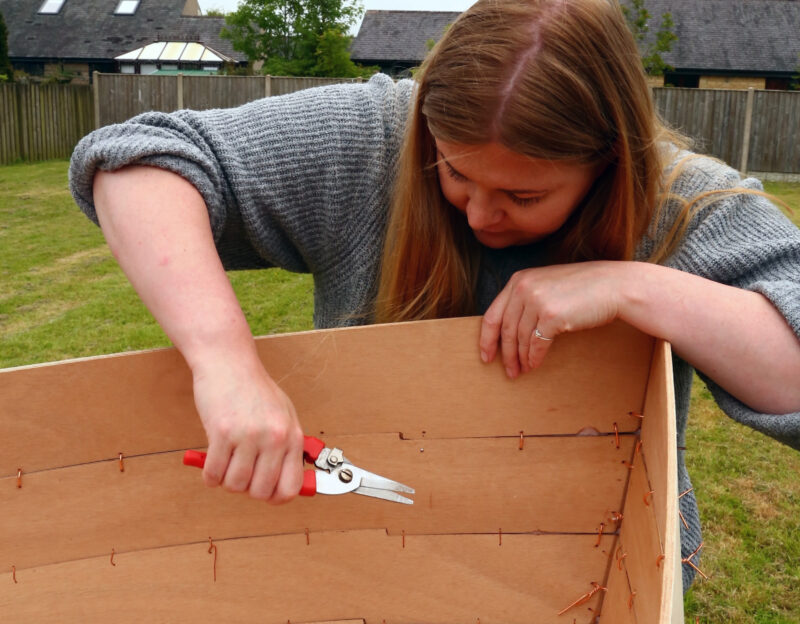
Once all the lands were glued up, Polly was able to flip the hull back to upright and snip out the copper wires.
Needing a space to build the boat, Polly talked to her father. Could she use his garage? “I promised him it would only take a couple of months of building weekends and then I’d be gone,” she says. “He’s always loved building boats, so he was fine with the idea.”
Her father wasn’t the only family mentor to be involved. “When my Granda died,” Polly says, “I inherited his tools. He had a lot of fastenings and fittings that he’d intended to use on boats he was going to build but hadn’t, and they all came to me. It was nice to use his old boatbuilding tools and some of the fittings. It felt like coming full circle.”
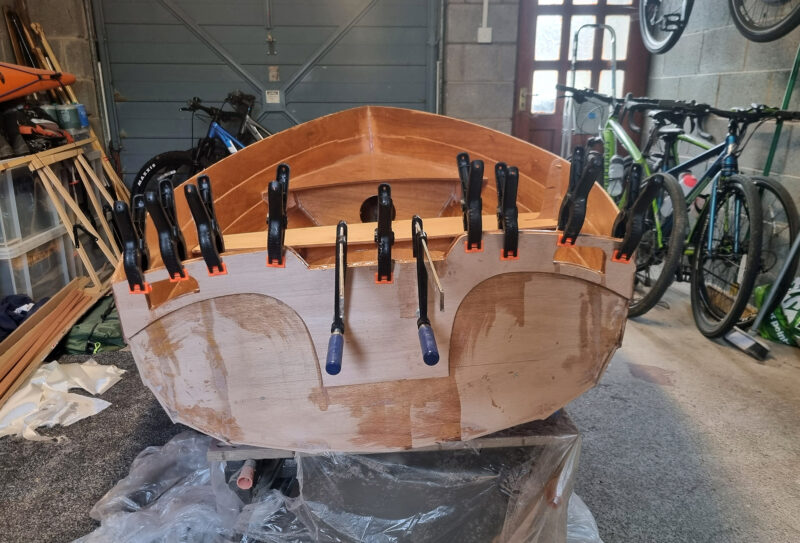
Back inside the garage, Polly glued up the transom. Typically the reinforcing panel goes on the inner face of the transom but Polly preferred the look of it on the outside, and also saw it as a good plate on which to mount the outboard.
Polly set up a building station in her father’s garage and laid the parts out on the floor. She was surprised to see how flat the side and bottom panels were. “The boat had been stitched together for years, so I thought the parts would retain some of their shape. But the plywood had no memory of the curve they’d been put into. None, they were just flat.”
As the boat slowly took shape, that flatness and the age of the material led to some nerve-wracking days.
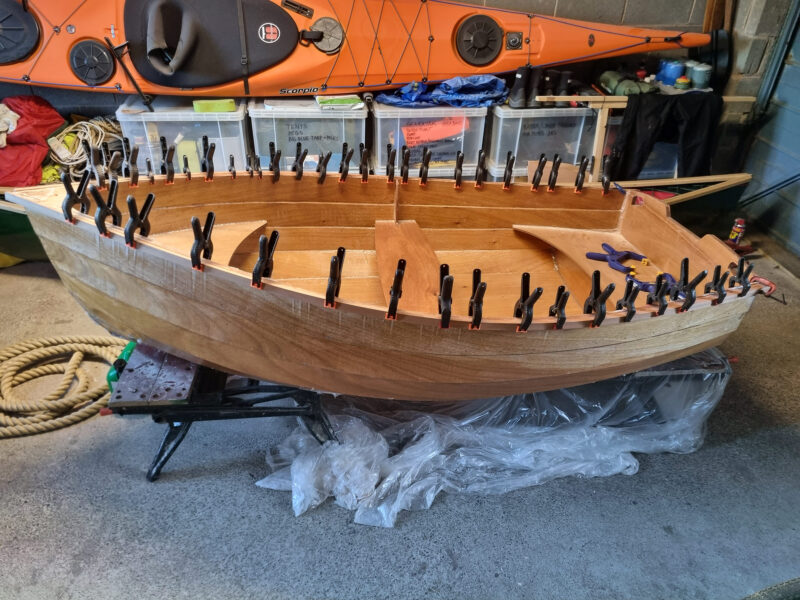
There’s no such thing as too many clamps. Polly glued up the two-piece sapele gunwale in situ.
“The Redshank is only 7′ 6″ long,” says Polly, “but its beam is 4′, so there’s a lot of curve in the planks. My father was an enthusiastic helper, and I don’t think I could have got the planks on without the extra pair of hands. Even with his help it was hard. I’d stitch a plank in place, bending it cautiously around the curve, and it’d get harder and harder toward the ends. I’d hear the plywood creaking and hold my breath. Whenever we’d finish a plank, I’d feel like I couldn’t leave, I’d sit and have a cup of tea and just wait for everything to start pinging off.”
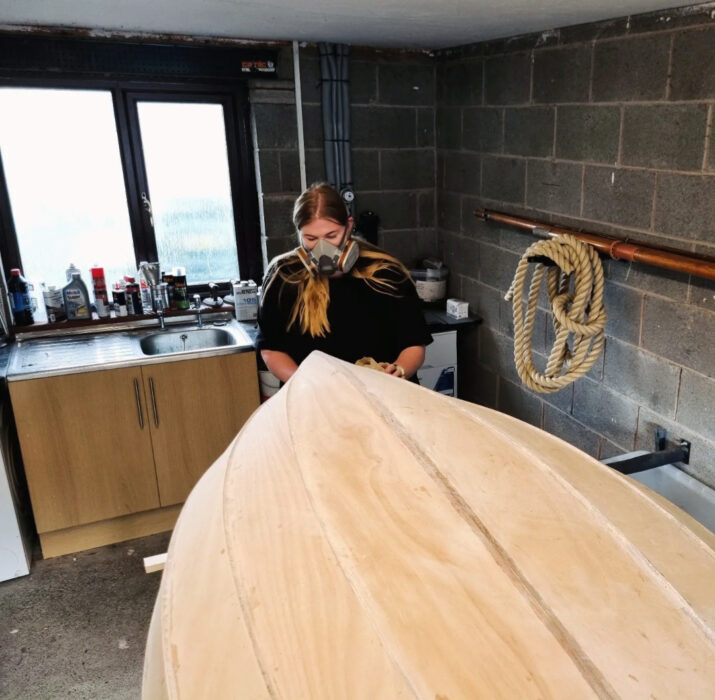
Polly works on fairing the outside of the hull prior to painting. The skeg (important for the boat’s tracking capabilities) would not be fitted until after the hull was finished.
As it turned out, nothing broke and, with the last of the planks stitched into place, Polly quickly turned to the epoxy and fiberglass. She started to breathe more easily. “It was such a relief when we got the epoxy fillets into the lands and the ’glass and epoxy over the whole hull. Only then did I trust that it was going to stay put!”
Despite her anxiousness, Polly managed the whole assembly without steam. “We did think about it. A friend who built a Redshank used a steambox, but in the end we managed without.”
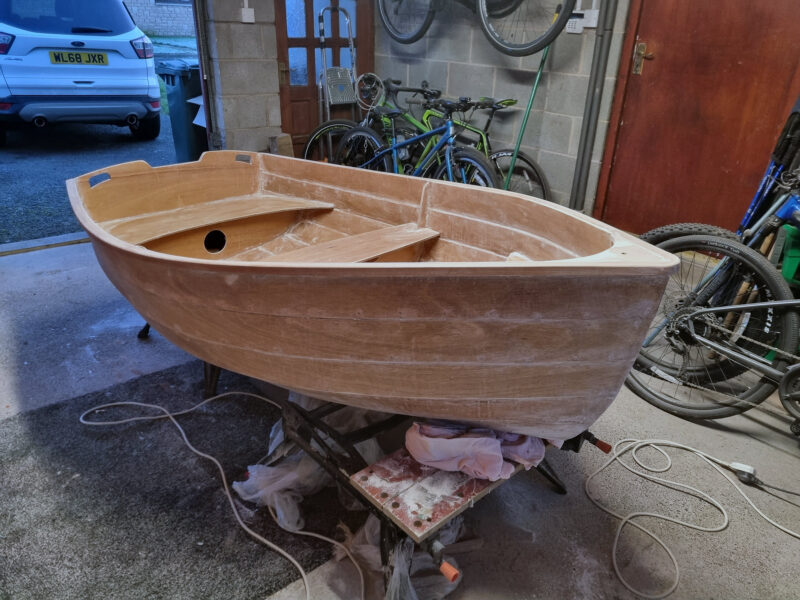
In the ends of the Redshank the thwarts sit atop bulkheads to enclose generous buoyancy compartments accessed via removable hatches. The ’midship thwart sits on the central building frame.
For the gunwales, Polly used sapele. After the struggles with the planking, she decided to apply it in two pieces, each 7⁄8 × 1 1⁄8″, epoxied and clamped in place.
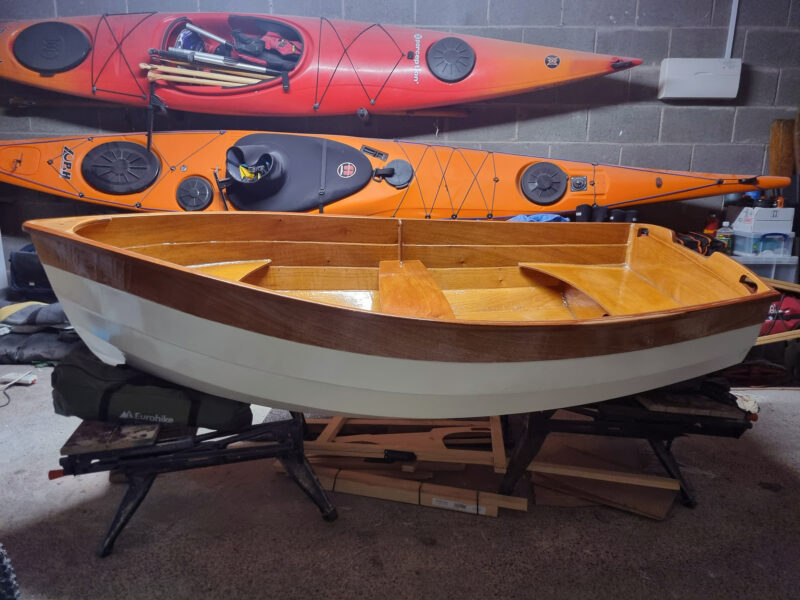
Once everything was painted and varnished all that remained was to install the bronze oarlock plates.
By the time most of the assembly was complete, summer was fast approaching. Polly’s original time frame would have been spot on but for one thing. “I went sailing,” she laughs. To justify the delay she explains, “The weather was great, and I was invited to go sailing on some different boats. I love sailing, it’s really my thing. So, yes, I went sailing up in Scotland, over in Norfolk on the East Coast of England, and down on the South Coast as well. It was great, but the boatbuilding did get delayed. My estimate of the hours I’d need was probably pretty close, but I was off having fun.”
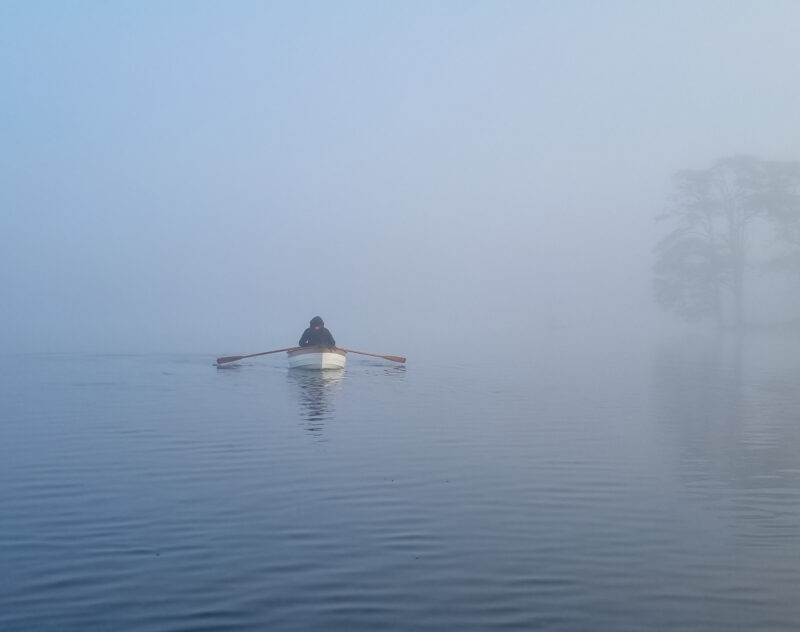
Launching day was calm and foggy—the perfect “Swallows and Amazons” day for a first row on Coniston Water.
PUFFIN was eventually launched on Coniston Water in England’s Lake District in the autumn. But, despite her late arrival, she quickly became a family favorite. Polly mounted a 30-year-old 2.3-hp Mariner outboard on the transom and bought a pair of 6′ 6″ oars. Even though the boat is only 7′ 6″ long, thanks to the beam, she says, “you can fit loads into her. The kids and I have used her to go up the lake, over to Wild Cat Island, swimming, or we’ve just zoomed around. Plus, Conor, who’s 11, likes to fish so he’s been going out in her on his own. And she looks pretty!”
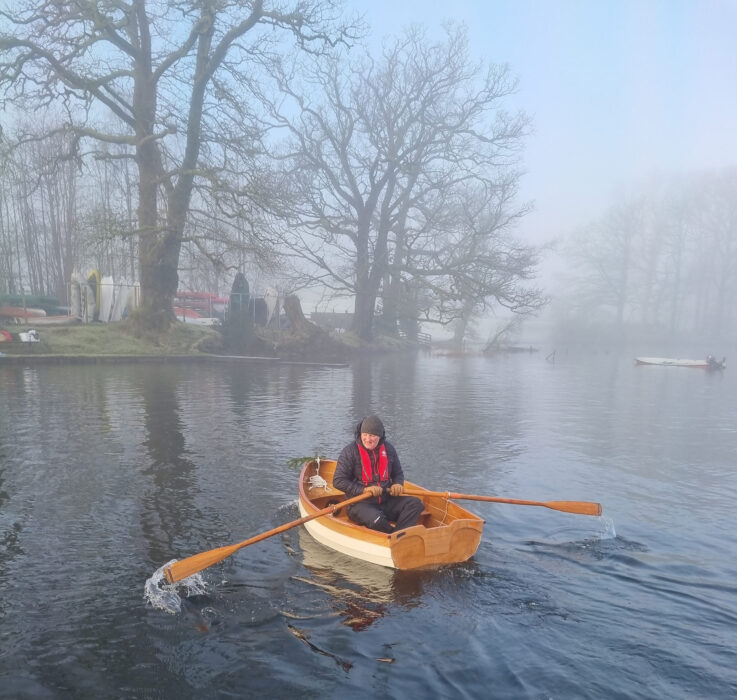
Polly’s father, Paul Robinson, rowing PUFFIN on her first excursion.
Polly is now volunteering at Windermere Jetty Museum in Bowness. She works in the conservation boatshop helping with projects as diverse as steaming and fitting new timbers in a lapstrake sailboat and scraping paint off a 100-year-old carvel-planked steamboat. And she’s already excited to be thinking of her next project. The family is hoping to “build a house on the Inner Hebridean island of Tiree,” she says, “and once that’s done, we’re going to need a boat to use up there. I’m thinking a Tolman Alaskan Skiff would go well. They’re 22′ with a cabin, so a bit of a step up from PUFFIN, but who knows!”![]()
Jenny Bennett is managing editor of Small Boats.
Do you have a boat with an interesting story? Please email us. We’d like to hear about it and share it with other Small Boats readers.
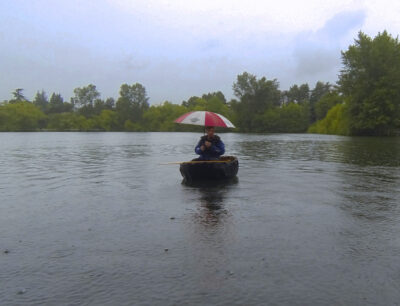
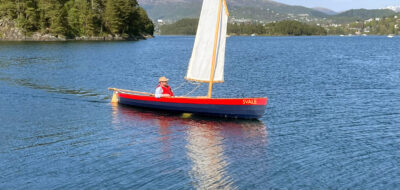

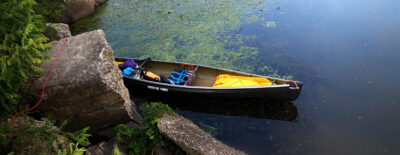
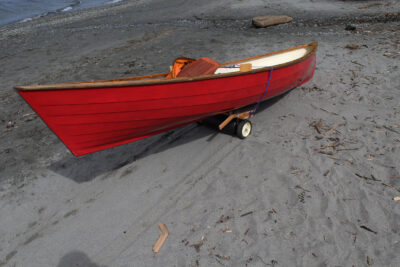
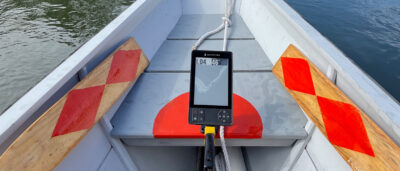
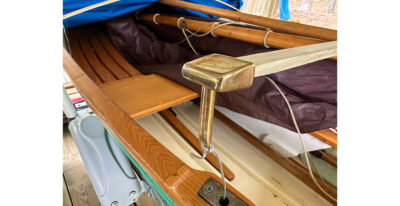
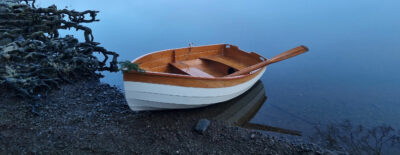
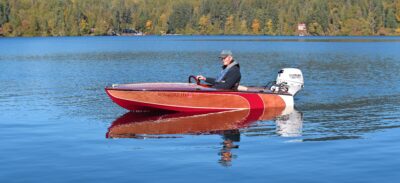
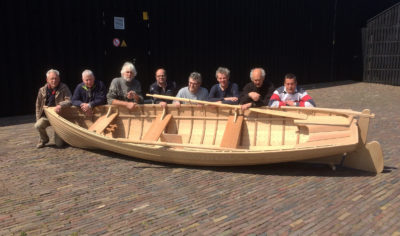
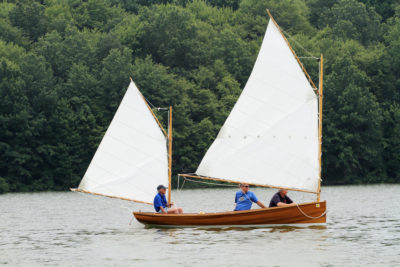
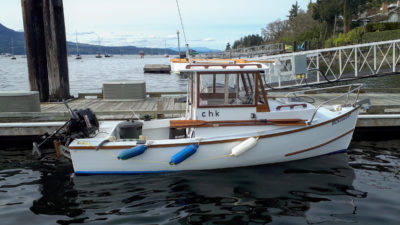
Bravo, great job saving such a beautiful boat from destruction!
I am sure it will be used frequently. The late Robb White, boat builder and designer, said, “the amount of time that a boat is used is inversely proportional to its size.” Not sure if he was the original author of that phrase but it is true.
What a cute little boat. Great save. I have a long history of dumpster diving. One man’s trash… Good call on the Tolman skiff, it will be a terrific boat no matter what you use her for.
Absolutely love your work.